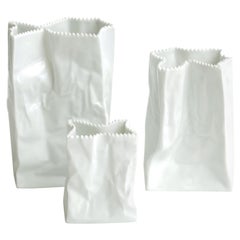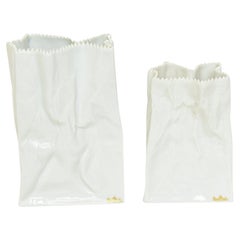Rosenthal White Ceramic Bags
Vintage 1970s German Modern Ceramics
Ceramic
People Also Browsed
Mid-20th Century German Mid-Century Modern Jars
Porcelain
20th Century German Mid-Century Modern Decorative Boxes
Porcelain
Late 20th Century German Mid-Century Modern Vases
Porcelain
Vintage 1970s German Mid-Century Modern Vases
Porcelain
Early 20th Century Pitchers
Stoneware
Early 20th Century German Victorian Figurative Sculptures
Porcelain
Antique Late 19th Century Unknown Victorian Busts
Porcelain
Vintage 1960s Italian Mid-Century Modern Pitchers
Ceramic
Vintage 1980s German Modern Porcelain
Porcelain
Antique Late 19th Century Victorian Toys
Ceramic
Vintage 1920s German Art Deco Porcelain
Porcelain
Antique 1850s German Classical Greek Porcelain
Porcelain
Mid-20th Century Swedish Scandinavian Modern Vases
Ceramic, Stoneware
Antique 19th Century British Victorian Pitchers
Sterling Silver
2010s Turkish Pitchers
Crystal
2010s Italian Post-Modern Floor Lamps
Marble
Recent Sales
Vintage 1970s German Modern Ceramics
Ceramic
Rosenthal for sale on 1stDibs
While the Rosenthal Porcelain Factory grew from humble decorating roots — as many pottery companies do — it eventually built a list of universally revered designer and artist partners that included Andy Warhol and Salvador Dalí. And after securing an enviable position as a top manufacturer of serveware and dominating the porcelain and bone china markets, Rosenthal expanded into furniture production, working with influential designers Verner Panton, Luigi Colani and Günther Ferdinand Ris and Herbert Selldorf.
German-born Jewish businessman Philipp Rosenthal founded the company in 1879 in Bavaria. It began as his modest workshop where he painted porcelain and encountered success with porcelain ashtrays. Rosenthal hired the best designers and clay modelers he could find. Adolf Oppel designed figurative Art Nouveau pieces, while Eleonore (Lore) Friedrich-Gronau produced decorative objects, namely her graceful porcelain dancer figurines, for the company.
Dinnerware, though, would be a Rosenthal mainstay. Between 1904 and 1910, Rosenthal produced its renowned dinnerware lines such as Donatello, Darmstadt and Isolde. These were introduced as unornamented white pieces — only later were they given their underglaze designs.
Rosenthal founder Philipp, a Catholic of Jewish ancestry, resigned in 1934 as the company’s president due to pressures owing to discriminatory German laws that took shape during the rise of the Nazi regime. Rosenthal died in 1937, and the family fled to America. The company would not regain its footing until 1950 when Rosenthal’s son, Philip, joined the firm and, in 1958, became chairman and dubbed Germany’s “China King.” At its peak, the company had 10,000 employees.
In the 1950s, Rosenthal’s modernist dinnerware was a significant part of the brand’s offerings, and by 1961 they introduced the famed Rosenthal Studio Line. Although furniture designers and ceramicists would lead the list of individuals working with Rosenthal — among them Tapio Wirkkala, Max Weber and Lisa Larson — the company eventually reached out to fine artists, not only Dalí and Warhol but Sandro Chia and Kenny Scharf. Rosenthal also collaborated with fashion designers Gianni Versace and Donatella Versace.
In a daring move in 1972, the company diversified into furniture, collaborating with some of the giants of mid-century modern design. The revolutionary Sunball chair, an icon of Space Age seating crafted by Selldorf and Ris, was among Rosenthal’s stellar successes in this venture.
On 1stDibs, find vintage Rosenthal ceramics, porcelain, tableware, seating and more.
A Close Look at modern Furniture
The late 19th and early 20th centuries saw sweeping social change and major scientific advances — both of which contributed to a new aesthetic: modernism. Rejecting the rigidity of Victorian artistic conventions, modernists sought a new means of expression. References to the natural world and ornate classical embellishments gave way to the sleek simplicity of the Machine Age. Architect Philip Johnson characterized the hallmarks of modernism as “machine-like simplicity, smoothness or surface [and] avoidance of ornament.”
Early practitioners of modernist design include the De Stijl (“The Style”) group, founded in the Netherlands in 1917, and the Bauhaus School, founded two years later in Germany.
Followers of both groups produced sleek, spare designs — many of which became icons of daily life in the 20th century. The modernists rejected both natural and historical references and relied primarily on industrial materials such as metal, glass, plywood, and, later, plastics. While Bauhaus principals Marcel Breuer and Ludwig Mies van der Rohe created furniture from mass-produced, chrome-plated steel, American visionaries like Charles and Ray Eames worked in materials as novel as molded plywood and fiberglass. Today, Breuer’s Wassily chair, Mies van der Rohe’s Barcelona chair — crafted with his romantic partner, designer Lilly Reich — and the Eames lounge chair are emblems of progressive design and vintage originals are prized cornerstones of collections.
It’s difficult to overstate the influence that modernism continues to wield over designers and architects — and equally difficult to overstate how revolutionary it was when it first appeared a century ago. But because modernist furniture designs are so simple, they can blend in seamlessly with just about any type of décor. Don’t overlook them.
Finding the Right abstract-sculptures for You
Abstract sculpture has evolved over time with artists making a variety of striking statements in stone, bronze, ceramic and other materials. In the collection of abstract sculptures on 1stDibs, you are sure to find a piece that is perfect for your space.
When exploring how to arrange furniture and decor, consider color, texture and what kind of energy it should evoke. Abstract sculpture can elevate any home through its many decorative possibilities.
Auguste Rodin is often called the father of modern sculpture for his pioneering naturalistic forms and figures that vividly express emotion. His work in the 19th and early 20th centuries broke with artistic conventions and inspired modernism, leading to a new period of avant-garde abstraction.
Pablo Picasso and Georges Braque were among the first artists to push abstract sculpture into the mainstream. They helped define the Cubism movement, which focused on deconstructing the world abstractly. Other 20th-century artistic movements, including Italian Futurism, Dadaism, Neo-Dadaism, Surrealism, Abstract Expressionism and Minimalism, all contributed to the advancement of abstract sculpture. Italian Futurism, for example, celebrated movement, dynamics and technology in abstract sculpture. These movements continue to inform abstract sculpture today.
With abstract art — sculpture, painting or a grouping of prints — a work can complement a living room, dining room or other space, or it can act as a bold focal point.
Browse a range of modern abstract sculptures, postmodern abstract sculptures and other sculptures on 1stDibs.



